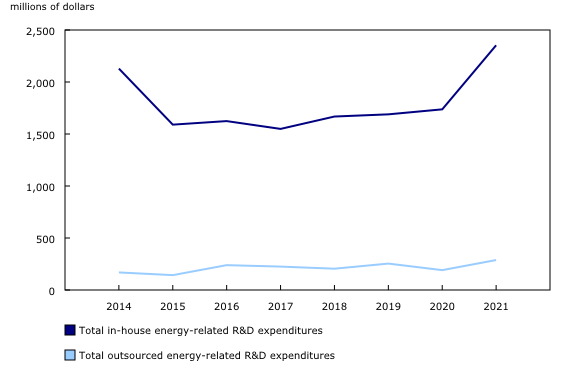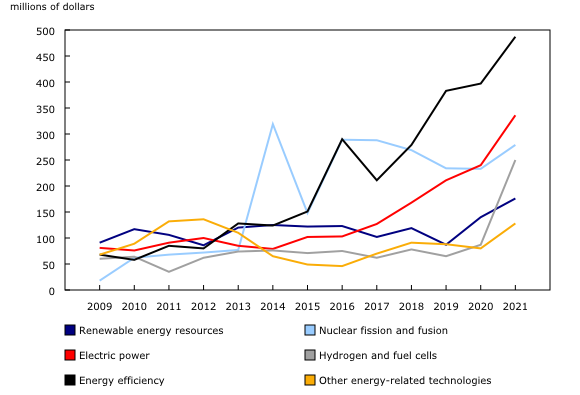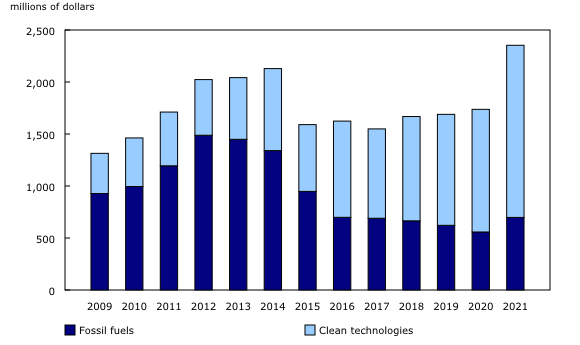Energy-related research and development expenditures, 2021
Released: 2023-09-29
Energy is a vital part of our modern industrial economy, as it powers our homes, vehicles, businesses and industries. By extension, energy-related research and development (R&D) by businesses serves to optimize the usage, reliability and affordability of energy.
With growing concerns about climate change and sustainability, energy-related R&D has taken on an even greater importance in Canada to further develop technological innovations that protect the environment and help achieve a net-zero economy by 2050.
In-house spending on and outsourcing of energy-related research and development reach new highs
In 2021, in-house spending on energy-related R&D reached $2.4 billion, an increase of 35.5% from 2020 and the highest level of spending since 2014. As a proportion of overall in-house R&D spending, energy-related R&D accounted for 8.6% of the $27.3 billion spent by businesses in Canada in 2021, up from 7.3% in 2020.
Following a decrease in 2020, outsourced energy-related R&D spending rose by 50.8% in 2021 to $288 million. This amount accounted for 5.0% of the $5.8 billion that businesses spent overall on outsourced R&D in 2021.
Research and development spending on clean technologies rose in 2021
Energy-related R&D is divided into seven areas of technology: fossil fuels, renewable energy resources, nuclear fission and fusion, electric power, hydrogen and fuel cells, energy efficiency, and other energy-related technologies. All areas except fossil fuels are considered clean technologies which are aimed at remediating or preventing environmental damages.
By investing and developing energy-related clean technologies, businesses in Canada play a central role in the energy transition to a more sustainable future. In 2021, spending in all areas related to clean technologies rose; the strongest growth of in-house R&D spending occurred in hydrogen and fuel cells, which rose $163 million to $250 million (+187.4%). The rise was mainly due to increased spending within the manufacturing sector (+$114 million). The growth in hydrogen and fuel cells is also in line with Canada's Hydrogen Strategy announced at the end of 2020, which identified goals of spurring investment and partnerships in hydrogen and lowering greenhouse gas emissions across many sectors, such as resources extraction, transportation, power generation and manufacturing.
Other notable clean technologies that saw increased spending in 2021 include electric power, which rose $96 million to $336 million (+40.0%), and energy efficiency, which rose $90 million to $487 million (+22.7%).
Research and development expenditures on fossil fuels increase but at a slower rate
In-house R&D expenditures on fossil fuels rose $140 million to $698 million in 2021, the first increase since 2012. Despite this increase, fossil fuels' proportion of total energy-related in-house R&D spending continued to decrease, down 2.4 percentage points to 29.7%. Most of the growth was in oil sands technologies (+$117 million to $426 million), which are tied to investments in improved methods of oil extraction.
Outsourcing of R&D spending on fossil fuels increased as well, up from $110 million to $133 million.
The overall increase in R&D spending on fossil fuels occurred as the economy rebounded in 2021 and the demand for energy increased, which, in turn, led to higher oil and gas prices.
Government funding in clean technologies rises
Government funding provided to businesses for energy-related R&D spending rose by 34.8% to $186 million in 2021. In total, government funding accounted for 7.9% of total in-house energy-related R&D spending.
The increase in government funding was recorded in all areas related to clean technologies. The largest portion of funding was directed towards energy efficiency, at 39.2% ($73 million), followed by renewable energy resources, at 16.1% ($30 million).
Overall, government funding in clean technologies increased by 41.4% (+$48 million). This increase reflects Canada's commitments to cleaner technologies through Mission Innovation, a global initiative of 23 countries and the European Commission that aims to increase investments in clean energy research and provide affordable and accessible clean energy solutions.
Foreign funding to businesses in Canada increased 29.1% to $151 million, representing 6.4% of all in-house energy-related R&D spending. Electric power received the largest share, with 36.4% ($55 million), followed by energy efficiency, with 23.8% ($36 million).
Sustainable Development Goals
On January 1, 2016, the world officially began implementing the 2030 Agenda for Sustainable Development—the United Nation's transformative plan of action that addresses urgent global challenges over the next 15 years. The plan is based on 17 specific sustainable development goals.
Data on energy-related research and development expenditures by area of technology are an example of how Statistics Canada supports the reporting on the Global Goals for Sustainable Development. This release will be used in helping to measure the following goals:


Note to readers
Energy-related technologies
Energy-related technologies include fossil fuels, renewable energy resources, nuclear fission and fusion, electric power, hydrogen and fuel cells, energy efficiency, and other energy-related technologies.
Definition of clean technologies
Clean technologies are defined as follows:
• Any good or service designed with the primary purpose of contributing to, remediating, or preventing any type of environmental damage;
• Any good or service that is less polluting or more resource-efficient than equivalent normal products which furnish a similar utility. Their primary use, however, is not one of environmental protection.
Data collection
The Energy Research and Development Expenditures by Area of Technology survey data are collected as part of the Annual Survey of Research and Development in Canadian Industry.
Random Tabular Adjustment
The Annual Survey of Research and Development in Canadian Industry and the associated Energy Research and Development Expenditures by Area of Technology survey, 2018, are the first annual surveys at Statistics Canada to use the Random Tabular Adjustment (RTA) technique, which aims to increase the amount of data made available to users while protecting the confidentiality of respondents.
Statistics Canada typically uses suppression techniques to protect sensitive statistical information. These techniques involve suppressing data points that can directly or indirectly reveal information about a respondent. This can often lead to the suppression of a large number of data points and significantly reduce the amount of available data.
Using RTA, Statistics Canada can identify sensitive estimates and randomly adjust their value rather than suppress them. The size of the adjustment is calculated to protect respondent confidentiality. After adjusting the value, the agency assigns a quality measure (A, B, C, D, or E) to the estimate to indicate the degree of confidence that users can have in its accuracy. Quality measures account for uncertainty related to sampling, nonresponse and RTA, when applied.
For more information on RTA, please refer to the blog article "Random Tabular Adjustment is here!" available as part of the StatCan Blog.
Products
The interactive dashboard, "Characteristics of research and development in Canadian industry" (71-607-X), is now available.
Contact information
For more information, or to enquire about the concepts, methods or data quality of this release, contact us (toll-free 1-800-263-1136; 514-283-8300; infostats@statcan.gc.ca) or Media Relations (statcan.mediahotline-ligneinfomedias.statcan@statcan.gc.ca).
- Date modified:



